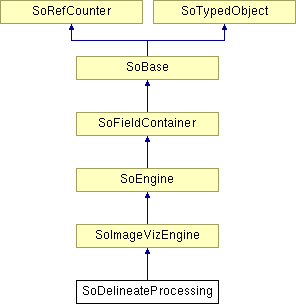SoDelineateProcessing Class Reference
[Sharpening]
 SoDelineateProcessing engine
More...
SoDelineateProcessing engine
More...
#include <ImageViz/Engines/ImageFiltering/Sharpening/SoDelineateProcessing.h>

Public Member Functions | |
| SoDelineateProcessing () | |
Public Attributes | |
| SoSFEnum | computeMode |
| SoSFEnum | neighborhood3d |
| SoSFImageDataAdapter | inImage |
| SoSFInt32 | elementSize |
| SoImageVizEngineOutput < SoSFImageDataAdapter, SoImageDataAdapter * > | outImage |
Detailed Description
 SoDelineateProcessing engine
SoDelineateProcessing engine
The SoDelineateProcessing engine provides contrast enhancement of an image.
For an introduction to image filters, see section Image Filters.
This engine provides contrast enhancement of an image using basic morphological transformations. Delineate is based on the fact that a function  is always between the erosion and the dilation of
is always between the erosion and the dilation of  .
.
![\[O(n,m,o)=\left\{\begin{array}{ll} D(I(n,m,o)) & \mbox {if $\left[D(I(n,m,o))- I(n,m,o)\right] < \left[E(I(n,m,o))-I(n,m,o)\right]$} \\ E(I(n,m,o)) & \mbox{otherwise} \end{array}\right.\]](form_417.png)
For each pixel, the output gray level value will be the closest value of  between the erosion and the dilation:
between the erosion and the dilation:
See also: SoDeblurProcessing2d.
FILE FORMAT/DEFAULT
- DelineateProcessing {
| computeMode | MODE_AUTO |
| neighborhood3d | CONNECTIVITY_26 |
| inImage | NULL |
| elementSize | 3 |
Library references: delineate delineate3d
Constructor & Destructor Documentation
| SoDelineateProcessing::SoDelineateProcessing | ( | ) |
Constructor.
Member Data Documentation
Select the compute Mode (2D or 3D or AUTO) Use enum ComputeMode.
Default is MODE_AUTO
The half size of the structuring element.
A structuring element always has an odd side length (3x3, 5x5, etc) which is defined by 2 * elementSize + 1. Default value is 3.
The input grayscale image.
Default value is NULL. Supported types include: grayscale binary label image.
In 3D configuration (see computeMode), the neighborhood connectivity defines the connectivity considered for processing adjacent voxels.
Use enum Neighborhood3d. Default is CONNECTIVITY_26.
The output image.
Default value is NULL. Supported types include: grayscale binary label color image.
The documentation for this class was generated from the following file:
- ImageViz/Engines/ImageFiltering/Sharpening/SoDelineateProcessing.h